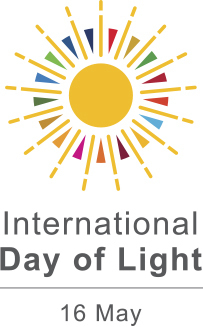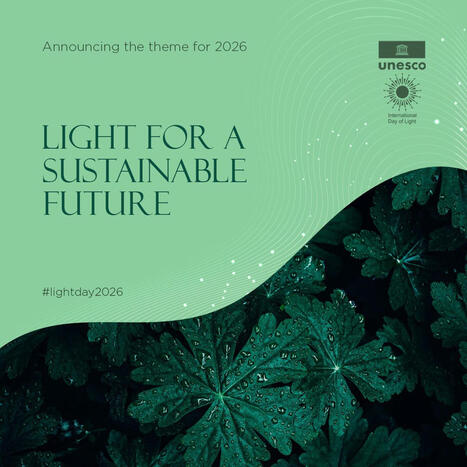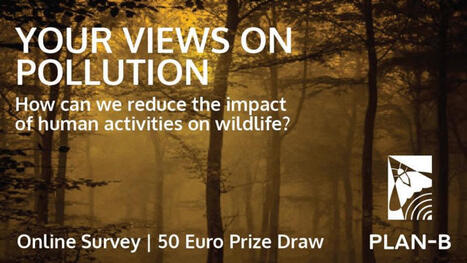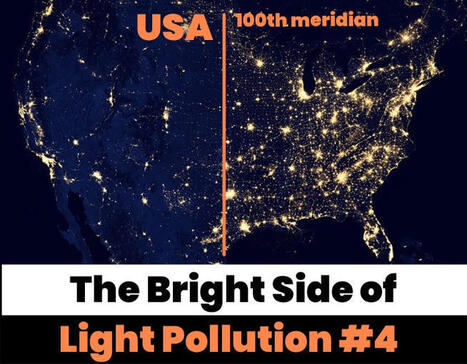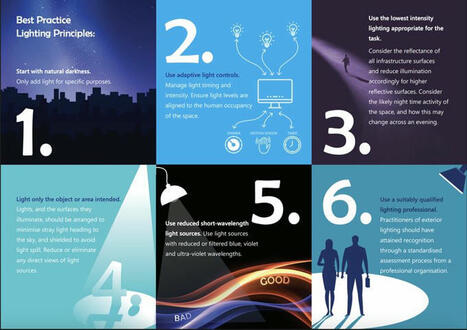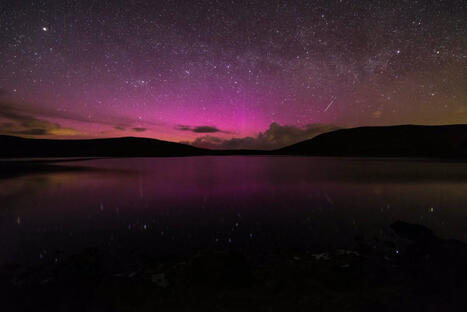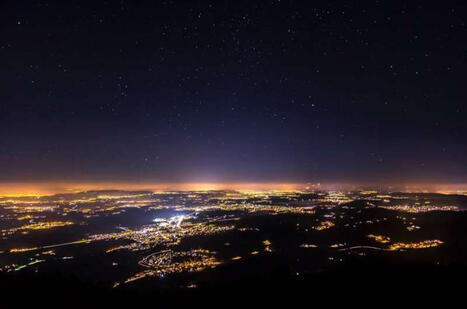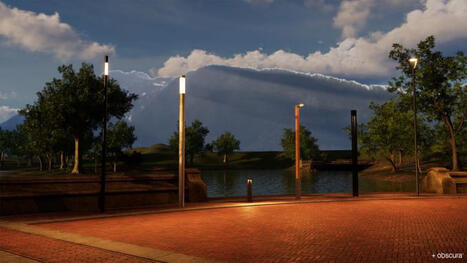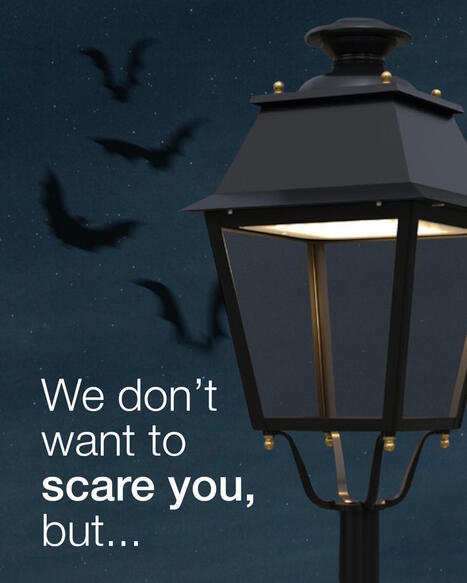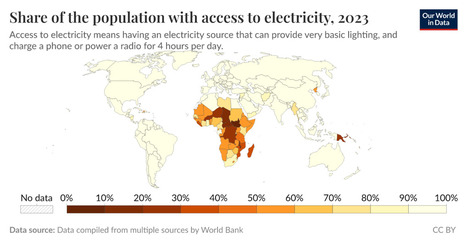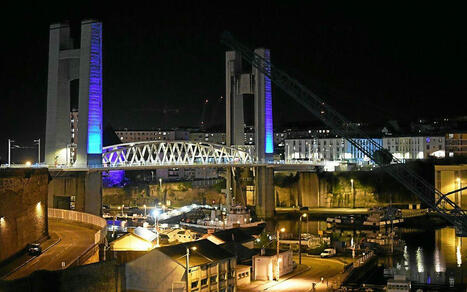 Your new post is loading...
 Your new post is loading...

|
Scooped by
LIGHTING
December 21, 2013 11:31 AM
|
LIGHTING-INNOVATION-DESIGN

|
Suggested by
Gilbert C FAURE
Today, 1:33 PM
|

|
Suggested by
Gilbert C FAURE
Today, 1:33 PM
|
📣 🗞 We have a theme for upcoming #lightday2026❗🗞📣
🔆 💡 Light For A Sustainable Future 💡 🔆
🟩 The theme highlights how light-based technologies drive sustainability in areas such as low energy lighting, green manufacturing, and improved agriculture.
🟩 The theme also encourages the next generation into education in science, engineering and technology.
🟩 The theme links to the priorities of UNESCO and the United Nations Sustainable Development Goals (SDGs), and supports the International Decade of Sciences for Sustainable Development.
🔔 Start planning events and activities for 2026 raising awareness associated with the 2026 theme. Event registrations are open!
🗞 For more details and updates, check out our latest newsletter: https://lnkd.in/ejmqznpa
#lightday2026

|
Suggested by
Gilbert C FAURE
Today, 1:33 PM
|
𝐇𝐞𝐥𝐩 𝐔𝐬 𝐔𝐧𝐝𝐞𝐫𝐬𝐭𝐚𝐧𝐝 𝐏𝐞𝐨𝐩𝐥𝐞’𝐬 𝐏𝐞𝐫𝐜𝐞𝐩𝐭𝐢𝐨𝐧𝐬 𝐨𝐟 𝐋𝐢𝐠𝐡𝐭 𝐚𝐧𝐝 𝐍𝐨𝐢𝐬𝐞 𝐏𝐨𝐥𝐥𝐮𝐭𝐢𝐨𝐧
Light and noise pollution are growing #environmental issues and recognised threats to biodiversity. Yet, they often receive far less attention than they deserve.
As part of the PLAN-B Project, we are conducting a survey to better understand public attitudes towards light and noise pollution, how they compare to other environmental challenges, and how acceptable different mitigation measures might be.
This online #survey forms part of a wider study exploring the social and psychological factors influencing these issues. It is led by our colleagues Michael Lomas PhD and Graeme Sherriff from The University of Salford, and takes approximately 15 minutes to complete.
𝐖𝐡𝐚𝐭 𝐝𝐨 𝐰𝐞 𝐧𝐞𝐞𝐝 𝐟𝐫𝐨𝐦 𝐲𝐨𝐮?
We kindly invite you to take part. Every response matters, and your insights will help us understand how people perceive light and noise pollution and what actions might be needed to address them.
How do these forms of pollution affect you?
What changes should be made?
What would you support?
𝐒𝐡𝐚𝐫𝐞 𝐲𝐨𝐮𝐫 𝐭𝐡𝐨𝐮𝐠𝐡𝐭𝐬 𝐰𝐢𝐭𝐡 𝐮𝐬!
Take part in the survey and be in with a chance to win €50!
𝐏𝐚𝐫𝐭𝐢𝐜𝐢𝐩𝐚𝐭𝐞 𝐡𝐞𝐫𝐞: https://lnkd.in/ewwn8RGS
Please also 𝐬𝐡𝐚𝐫𝐞 𝐭𝐡𝐞 𝐬𝐮𝐫𝐯𝐞𝐲 with your friends, colleagues, family, and networks. The more people take part, the stronger and more meaningful our results will be.
Thank you for helping us work towards healthier nights and quieter cities🌍✨
Yana Yakushina
Fundación Ibercivis
Daniel Lisbona
#LightPollution #NoisePollution #Biodiversity #EnvironmentalAwareness #PLANBProject #HorizonEurope #DarkSkyProtection #UrbanSustainability #HealthyCities #Wellbeing #CitizenScience #PolicyResearch #EnvironmentalPsychology

|
Suggested by
Gilbert C FAURE
Today, 1:33 PM
|
The key wavelengths for human health are missing from most LEDs. In the race to provide the cheapest brightness (maximum lumens per watt), conventional LEDs fail to provide the vital 380 nm, 430 nm & 480 nm wavelengths that stimulate the non-visual opsins (light-sensitive proteins) in the eye essential for good health.
As explained in my Substack article https://lnkd.in/eTq4e42C our eyes were
designed to see light at:
~380 nm (Opsin 5: eye develop, myopia prevent & glucose regulation)
~430 nm (Opsin 3: eye development & glucose regulation)
~480 nm (Opsin 4: Melanopsin - circadian rhythm synchronization)
and our bodies were designed to absorb infrared light at:
~825 nm (direct stimulation of mitochondrial energy production)
Modern LEDs may do a good job of stimulating the Visual Opsins 1 (Color vision) & 2 (Rhodopsin night vision).
But they totally fail at providing light at the critical wavelengths essential for health.
It is time that LED manufacturers realize that light is not just about vision, it is also essential for health.
To learn more and protect your health read my book THE LIGHT DOCTOR https://lnkd.in/e3yrfuBb | 52 comments on LinkedIn

|
Suggested by
Gilbert C FAURE
Today, 1:32 PM
|
At first, it looks like a random pattern of lights: the United States glowing proudly from coast to coast.
But look closer.
There’s a line.
A straight, invisible divide cutting the country in two.
To the east: dense cities, farms, humidity, and growth.
To the west: dry lands, sparse lights, and silence.
That line isn’t political or cultural: it’s natural.
The 100th meridian, where the humid east meets the arid west.
Where agriculture once stopped, and survival changed shape.
Light pollution here becomes a climate map drawn by human hands: proof that even our chaos follows the rules of nature.
This is part of my Tuesday mini-series, exploring how our artificial light reveals the deepest patterns of life, wealth, and geography on Earth.
Light pollution is destructive. Yet, paradoxically, it tells the story of who we are. And while it offers us this anthropological lens, we must still fight it , for our health, our ecosystems, and our future.
💡 I’m available for lectures, webinars or talks on light, the human body, Human Centric Lighting, sustainability and yes, even light pollution.
If you’d like to explore these topics outside the usual clichés, feel free to contact me.

|
Suggested by
Gilbert C FAURE
Today, 1:32 PM
|
GO W.A! I’m blown away by how much effort, funding and activity is being invested in dark skies across Western Australia. It really looks like you’re leading the W.A.y.
From world-class astrotourism experiences to immersive education at Scitech, Western Australia is showing how communities, science and tourism can come together to protect one of our most precious natural assets: the night sky.
The new Light Pollution exhibit at Scitech’s Here, There and Everywhere gallery is a powerful example. Visitors can experience the impact of light pollution on turtle hatchlings and the stars above, while learning how small changes in the way we use light can make a big difference for wildlife and future generations.
It’s inspiring to see this kind of leadership.
With initiatives like this, W.A. isn’t just protecting its skies – it’s setting a benchmark for the rest of Australia (and the world).
Great work Carol Redford Tristan Simpson and Scitech

|
Suggested by
Gilbert C FAURE
Today, 1:31 PM
|
🇬🇧 Proud and delighted to see our collective work honored with the 2025 Janus Design Award!
A huge bravo to all the Ghm & Eclatec teams who brought CELLA to life—a creation by Christophe Canadell that reimagines the iconic Chenonceaux and carries it into the smart-lighting era.
Proof that aesthetics, technology, and responsibility can move forward together.
🇫🇷 Fier et heureux de voir notre travail collectif distingué par le Janus du Design 2025 !
Un immense bravo à toutes les équipes Ghm France & Eclatec France qui ont donné vie à CELLA, une création signée Christophe Canadell qui réinvente l’icône Chenonceaux et l’emmène vers le smart lighting de demain.
Preuve qu’esthétique, technologie et responsabilité peuvent avancer ensemble.

|
Suggested by
Gilbert C FAURE
Today, 1:31 PM
|
The program is up for our 9th International Artificial Light t Night Conference. https://lnkd.in/exJmCa-Y
October 28-31, 2025, Westport, IRELAND
The ALAN Conference "is the largest international scientific conference on the impacts of artificial light at night, covering the topics of biology & ecology, governance ®gulation, health, measurement & modeling, social sciences and humanities, and technology & design."
Chairs:
Dr. Annette Krop-Benesch (co-chair), Initiative Nachhaltig Beleuchten, Berlin, Germany
Dr. Salvador J. Ribas (co-chair), Parc Astronòmic Montsec – Consell Comarcal de la Noguera & Universitat de Barcelona
Ms. Diane Turnshek (co-chair), Special Faculty member of the Department of Physics at Carnegie Mellon University (lecturer)
and Adjunct Assistant Professor in the Department of Physics and Astronomy at the University of Pittsburgh, PA, USA

|
Scooped by
LIGHTING
October 5, 12:53 PM
|

|
Suggested by
Gilbert C FAURE
October 5, 12:49 PM
|

|
Suggested by
Gilbert C FAURE
October 5, 12:49 PM
|
Perché sur des collines isolées au sud de Palerme, le domaine extrait d’une terre de vin millénaire des grands crus élevés en biodynamie. L’ancienne étable, rénovée en une sobre maison rustique, accueille les visiteurs pour des nuitées au milieu des vignes.

|
Suggested by
Gilbert C FAURE
October 5, 12:49 PM
|
|

|
Suggested by
Gilbert C FAURE
Today, 1:34 PM
|
Tired of an increasingly boring academy? Well, there is always hope (for the time...). If you want to participate in two initiatives that will shape the future of studies on nocturnal cities and nighttime tourism, I invite you to send your proposals to:
1) Call For Abstracts Proposals: "The Palgrave Handbook on Nocturnal Cities", edited by Dr. Manuel García Ruiz (ISCTE–IUL) & Dr. Jordi Nofre (NOVA FCSH)
https://lnkd.in/dMX6DyWz
This forthcoming volume (expected publication mid-2027) explores the multiple dimensions of nocturnal urban life—its atmospheres, economies, inequalities, and transformations. Extended deadline: 15 November 2025.
2) Call For Papers: Special Issue of Tourism Geographies (Q1) "After Dark – Exploring Nighttime Tourism in Tourism Geographies (Special Issue)". Guest Editors: Dr. Manuel García Ruiz (ISCTE–IUL) & Dr. Jordi Nofre (NOVA FCSH)
https://lnkd.in/dAkvyu3n
Tourism studies have long focused on daylight experiences — yet the night is increasingly becoming a vital space of touristic, cultural, and affective practices. From light festivals and open-air concerts to gastronomic trails, pilgrimages, queer nightlife, and stargazing, this special issue foregrounds the night as a crucial analytical lens for understanding contemporary tourism geographies. We invite contributions exploring: Cultural, creative, and event-based tourism after dark; Nocturnal atmospheres, rhythms, and affective practices; Governance, sustainability, and aesthetic economies of the night; Comparative and interdisciplinary approaches to nighttime tourism. Deadline: 15 November 2025

|
Suggested by
Gilbert C FAURE
Today, 1:33 PM
|
Artificial light at night not only increases emission of CO2 as of high electricity demand but has also other - until now - unknown effects on climate change.
"Artificial Light At Night" (ALAN) is increasing carbon released by plants and animals across continents—without any increase in the carbon they absorb.
Link to the news item explaining the observation: https://lnkd.in/eJaZYFkh
Link to the study (nature): https://lnkd.in/euHTvV5t
DOI: 10.1038/s41558-025-02481-0.
#lightpollution #climatechange #globalwarming #cop30 #lighting

|
Suggested by
Gilbert C FAURE
Today, 1:33 PM
|
🙏 A big thank you to our international #partners and #testers who enabled us to conduct this first #beta test sequence, which ends today, allowing us to begin the #final stages of #Obscura's development:
➡️ consolidation of #photometric calculations
➡️ improvement of software #stability
➡️ expansion of the manufacturer #catalog
➡️ improvement of 3D import functions to #BIM technology
➡️ improvement of #multilingual systems
📆 In early 2026, we will open Obscura to the first users in the lighting industry.
✅ If you are a manufacturer and would like to be included in the catalog, please send us a private message.
✅ If you work in the lighting, architectural, retail, landscape or urbanism industry and would like more information about the software, please send us a private message.
See you soon for the next stage of the program.
#Obscura #lightingdesign #digitaltwin #software #innovation

|
Suggested by
Gilbert C FAURE
Today, 1:33 PM
|
Trick or treat? 👻
The real trick is fighting light pollution.
And that’s what we do, every day of the year.
Join us in our journey towards a more sustainable, respectful future!
Let’s keep the stars shining. ✨
https://lnkd.in/dfYDfviZ

|
Suggested by
Gilbert C FAURE
Today, 1:32 PM
|
An interactive visualization from Our World in Data.

|
Suggested by
Gilbert C FAURE
Today, 1:32 PM
|

|
Suggested by
Gilbert C FAURE
Today, 1:31 PM
|
Did switching off street lights at night increase crime—or reduce it?
Dr Phil Edwards from the London School of Hygiene & Tropical Medicine, lead of the LANTERNS Project, shares new NIHR-funded research showing that streets with part-night lighting saw vehicle thefts drop by half compared with before the change.
Using 10 years of Thames Valley police data, the study explored how part-night lighting, dimming, and white light affected burglary, robbery, vehicle crime, and violence—challenging assumptions that more light means more safety.
Join this webinar to discover how smarter, evidence-based lighting can cut energy use while keeping communities safe.
#darkskies #safety #crime #streetlighting
IPWEA Adam Carey MIES David Bird FIALD. FIES. CLD Landon Bannister Australian Local Government Association

|
Suggested by
Gilbert C FAURE
Today, 1:31 PM
|
Our collegue and scientific coordinator of PLAN-B Project Yana Yakushina has participated in the last podcast of Light Pollution News, and interesting conversation about raising awarness of #lightpollution.
She quotes at Frank Turina, PhD when he says "𝘊𝘰𝘮𝘣𝘪𝘯𝘨 “𝘭𝘪𝘨𝘩𝘵” 𝘢𝘯𝘥 “𝘱𝘰𝘭𝘭𝘶𝘵𝘪𝘰𝘯” 𝘤𝘩𝘢𝘯𝘨𝘦𝘴 𝘩𝘱𝘸 𝘱𝘦𝘰𝘱𝘭𝘦 𝘵𝘩𝘪𝘯𝘬 - 𝘴𝘶𝘥𝘥𝘦𝘭𝘯𝘭𝘺, 𝘺𝘰𝘶 𝘳𝘦𝘢𝘭𝘪𝘴𝘦 𝘯𝘰𝘵 𝘢𝘭𝘭 𝘭𝘪𝘨𝘩𝘵 𝘪𝘴 𝘨𝘰𝘰𝘥". In her words, calling something “pollution” brings people’s attention to ALAN as a possible form of harm. After we get this attention, we can think how we can change or reduce light.
We invite you to listen to the podcast an leave your comments about this matter: having a clear "name" (such as "light pollution) help us to raise awarness of the issues that we want to address?

|
Suggested by
Gilbert C FAURE
Today, 1:31 PM
|
📣 Brest Métropole fait partie des 17 territoires labellisés « Villes et villages étoilés » sur la période 2024-2025. Une première qui salue ses efforts pour limiter la pollution lumineuse nocturne.
https://lnkd.in/eZH3Riq8
Brest Métropole, DARKER SKY - Interreg North Sea Project, Saïg Potard, Glen Dissaux, Laboratoire Géoarchitecture. Territoires, Urbanisation, Biodiversité, Environnement.Université de Bretagne Occidentale

|
Suggested by
Gilbert C FAURE
October 5, 12:49 PM
|
uMap permet de créer des cartes personnalisées sur des fonds OpenStreetMap en un instant et les afficher dans votre site.

|
Suggested by
Gilbert C FAURE
October 5, 12:49 PM
|
Combien peut-on économiser en éclairage public ?
Pour répondre à cette question, nous utilisons une plateforme cartographique de simulation simple et efficace, qui fonctionne en 3 étapes :
💡 identifier les sources lumineuses les plus #énergivores.
🔋 Indiquer la #puissance envisagée après rénovation.
📅 Indiquer la #durée de fonctionnement annuelle après rénovation.
Résultat ? Une comparaison #dynamique et #immédiate entre :
🪫La consommation énergétique actuelle et celle projetée.
💰Les coûts actuels et ceux projetés.
En vidéo, la démonstration sur la base de données de Nantes Métropole, disponible en #Opendata. On découvre que :
⚡L'échantillon de 200 points lumineux sélectionnés indique une #puissance moyenne par point de 416,3 W, soit 364 670 kWh/an si l'on part du principe que c'est un éclairage #permanent.
💲Le #coût de l'énergie actuellement consommée par ces 200 sources est de 91 167,5 €/an sur une base de 0,25 € du kWh, sans compter les frais d'abonnement, d'acheminement ou encore de maintenance.
↘️La consommation #énergétique annuelle descend à 43 800 kWh/an et son coût à 10 950 €/an, sur la base des mêmes indicateurs (régime permanent, 0,25 € du kWh), si l'on prend une puissance moyenne de #50W par source pour la #rénovation, pour atteindre 88% d'économies.
⬇️La consommation énergétique annuelle atteint 14 600 kWh/an, et son coût 3 650 €/an si l'on couple la puissance moyenne de rénovation de 50W à une pratique d'#extinction en cœur de nuit, pour atteindre 96% d'économies.
🎯L'objectif de la plateforme ? #Accompagner les décideurs et services des collectivités dans l'optimisation des choix et #financements de la rénovation de leur éclairage public, en leur permettant d'accéder à une vision #géographique immédiate des #priorités énergétiques, et des #économies accessibles.
Et dans votre ville, quelles sont les économies accessibles ? Testez dès à présent le démonstrateur, il est gratuit et ouvert à tous !
➡️ https://lnkd.in/en4SeDFb
🚀 Pour bénéficier des options avancées : sélection illimitée de sources lumineuses, calcul de retour sur investissement, planification des travaux, exports de bases de données et de rapports complets, contactez nous :
📩 contact@lobservatoiredelanuit.fr
#éclairagepublic #énergie #économies #planification #simulation

|
Suggested by
Gilbert C FAURE
October 5, 12:49 PM
|
There is growing evidence that artificial light at night (ALAN) has an adverse effect on human health and ecology. Long-term global studies also show …

|
Suggested by
Gilbert C FAURE
October 5, 12:48 PM
|
That’s not a sunrise.
The nighttime lights of Los Angeles are visible from a rural road 90 miles away.
Light doesn’t stay where you switch it on. Be cautious and aware.
https://lnkd.in/eHkTmc7n
#lightpollution
|





 Your new post is loading...
Your new post is loading...
